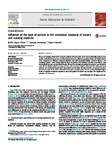Influence of the type of patient in the emotional response of nurses and nursing students
| dc.contributor.author | Lopez-Perez, B | |
| dc.contributor.author | Ambrona, T | |
| dc.contributor.author | Hanoch, Yaniv | |
| dc.date.accessioned | 2018-03-05T10:35:56Z | |
| dc.date.available | 2018-03-05T10:35:56Z | |
| dc.date.issued | 2016-07 | |
| dc.identifier.issn | 1471-5953 | |
| dc.identifier.issn | 1873-5223 | |
| dc.identifier.uri | http://hdl.handle.net/10026.1/10922 | |
| dc.description.abstract |
Nurses are playing a vital role in caring for patients. However, this can be very emotionally taxing. In two studies, professional nurses and nursing students from two different countries (Spain and United States) were compared on different measures-objective and self-perspective-taking, personal distress, and emotional impact—when facing different types of patients who suffered from the same illness: One terminally ill and one non-terminal. Results showed that the type of patient (terminal vs. non-terminal) only affected significantly the nursing students, who reported a higher self-perspective taking, personal distress, and emotional impact when the patient was terminal. Nursing students, compared to professional ones, seem to be more vulnerable to the type of patient they care for as they exhibited higher levels of negative emotional experience when the patient described was terminal. The significant implications are discussed. | |
| dc.format.extent | 7-11 | |
| dc.format.medium | Print-Electronic | |
| dc.language | en | |
| dc.language.iso | en | |
| dc.publisher | Elsevier BV | |
| dc.subject | Nurses | |
| dc.subject | Nursing students | |
| dc.subject | Personal distress | |
| dc.subject | Perspective taking | |
| dc.subject | Type of patient | |
| dc.title | Influence of the type of patient in the emotional response of nurses and nursing students | |
| dc.type | journal-article | |
| dc.type | Journal Article | |
| plymouth.author-url | http://gateway.webofknowledge.com/gateway/Gateway.cgi?GWVersion=2&SrcApp=PARTNER_APP&SrcAuth=LinksAMR&KeyUT=WOS:000381650700002&DestLinkType=FullRecord&DestApp=ALL_WOS&UsrCustomerID=11bb513d99f797142bcfeffcc58ea008 | |
| plymouth.volume | 19 | |
| plymouth.publication-status | Published | |
| plymouth.journal | NURSE EDUCATION IN PRACTICE | |
| dc.identifier.doi | 10.1016/j.nepr.2016.03.009 | |
| plymouth.organisational-group | /Plymouth | |
| plymouth.organisational-group | /Plymouth/REF 2021 Researchers by UoA | |
| plymouth.organisational-group | /Plymouth/REF 2021 Researchers by UoA/UoA04 Psychology, Psychiatry and Neuroscience | |
| plymouth.organisational-group | /Plymouth/Research Groups | |
| plymouth.organisational-group | /Plymouth/Research Groups/Centre for Brain, Cognition and Behaviour (CBCB) | |
| plymouth.organisational-group | /Plymouth/Research Groups/Centre for Brain, Cognition and Behaviour (CBCB)/Behaviour | |
| dc.publisher.place | Scotland | |
| dcterms.dateAccepted | 2016-03-25 | |
| dc.identifier.eissn | 1873-5223 | |
| dc.rights.embargoperiod | Not known | |
| rioxxterms.versionofrecord | 10.1016/j.nepr.2016.03.009 | |
| rioxxterms.licenseref.uri | http://www.rioxx.net/licenses/all-rights-reserved | |
| rioxxterms.licenseref.startdate | 2016-07 | |
| rioxxterms.type | Journal Article/Review |


